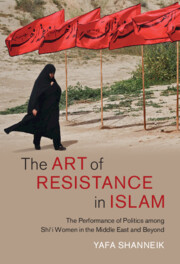 The Art of Resistance in Islam
The Art of Resistance in Islam Book contents
- The Art of Resistance in Islam
- Cambridge Middle East Studies
- The Art of Resistance in Islam
- Copyright page
- Contents
- Figures
- Preface
- Note on Transliteration
- Introduction
- 1 Trajectories of Shiʿis in the Gulf and Their Presence in Europe
- 2 The Rites of Mourning within Shiʿi Islam
- 3 Performing the Sacred
- 4 Aestheticization of Politics
- 5 Fatima’s Apparition
- 6 The Power of the Word
- 7 Conclusion
- Bibliography
- Index
- Books in the Series
1 - Trajectories of Shiʿis in the Gulf and Their Presence in Europe
Published online by Cambridge University Press: 06 January 2022
- The Art of Resistance in Islam
- Cambridge Middle East Studies
- The Art of Resistance in Islam
- Copyright page
- Contents
- Figures
- Preface
- Note on Transliteration
- Introduction
- 1 Trajectories of Shiʿis in the Gulf and Their Presence in Europe
- 2 The Rites of Mourning within Shiʿi Islam
- 3 Performing the Sacred
- 4 Aestheticization of Politics
- 5 Fatima’s Apparition
- 6 The Power of the Word
- 7 Conclusion
- Bibliography
- Index
- Books in the Series
Summary
This chapter provides an overview of the trajectories of Shi‘is in the Gulf and their presence in Europe. The Shi‘a in the Gulf consist of indigenous as well as migrant and, in some cases, also converted Shi‘is. Whether forced or voluntary, the experiences of migration and settlement among Shi‘is in Europe and the Middle East varies. Often coming from minority contexts of marginalization, discrimination, and persecution, Shi‘i experiences of migration are often different to those of other Muslim immigrants in Europe as well as in the Middle East. In the 1980s, large-scale displacement of Iraqi Shi‘i Muslims, for example, forced them to migrate through a multilocal trajectory of displacement in so-called transit countries such as Iran, other Gulf countries or neighboring countries such as Jordan or came first to European countries such as Sweden, the Netherlands or Germany and later moved to the United Kingdom. The national and transnational interactions and networks of these Shi‘i communities are discussed in this chapter to offer an overview of the various diverse Shi‘i communities present in Europe and the Middle East.
Keywords
- Type
- Chapter
- Information
- The Art of Resistance in IslamThe Performance of Politics among Shi'i Women in the Middle East and Beyond, pp. 35 - 64Publisher: Cambridge University PressPrint publication year: 2022
